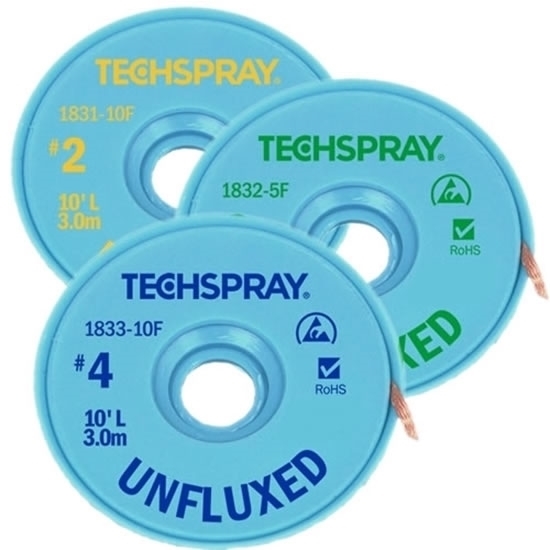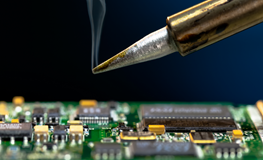
Unfluxed Desoldering Braid
Desoldering braid or desoldering wick is a pre-fluxed copper braid that is used to remove solder, which allows components to be replaced and excess solder (e.g. bridging) to be removed. The soldering iron is applied to the wick as it sits on the solder joint, and when both are brought up to the solder's melting point, the flux is activated and, through capillary action from the braided design, solder is drawn up the wick. Techspray wick has been a mainstay at PCB rework, repair and prototyping stations for over 30-years.
| Braid # | Color Code | Width (in) | Width (mm) |
| #1 | White | 0.035 | 0.9 |
| #2 | Yellow | 0.055 | 1.4 |
| #3 | Green | 0.075 | 1.9 |
| #4 | Blue | 0.098 | 2.5 |
Features & Benefits
- Apply your own flux
- Ideal for aqueous fluxes
- Allows flux matching in process
- Exceeds MIL-F-14256
- Anti-static spools

FAQ's
Out-of-date solder wick can create a performance issue. As more oxidation builds on the copper braid, it will take longer to activate and draw up solder. It will slow down a little month-to-month until eventually the performance will be unacceptable. We estimate this to be 2-years based on average storage conditions. Wick in storage wrapped up tight can last longer, while a loose bobbin sitting on a benchtop will probably go bad sooner.
An operator will generally have a feel for how wick performs and will have an opinion on when performance is unacceptable. The main risk of using out-of-date wick is thermally stressing the working area, adjacent components, etc. When an operator tries to make due with old wick that is underperforming, they tend to turn up the heat on their iron, or keep the tip in contact with the wick and work for a longer period of time.
So whether or not out-of-date wick is considered good depends on the criticality and conservativeness of your process. An average shop would keep using it until it stops working well. A very conservative process (e.g. for class 3 electronics) could require wick in stock to be discarded at the expiration date, and loose bobbins at workstations replaced periodically (i.e. weekly or monthly).
All you need is Techspray desoldering braid (wick) and a soldering iron. Here are the basic instructions:
- Place the braid over unwanted solder, preferably on the greatest solder build up so that it maximizes the contact of the braid to the surface area of the solder.
- Next, place your iron tip over the wick at 45 degrees and allow heat to transfer to the pad. Molten solder will absorb into the braid.
- Move the solder tip and braid as needed to remove all of the solder at one time. Careful not to drag the braid over the pads, which can scratch.
- Once the braid is full of solder, you must trim the spent portion and move to fresh braid in order to pull more solder. Remove the iron and braid simultaneously to avoid soldering the wire to the board.




